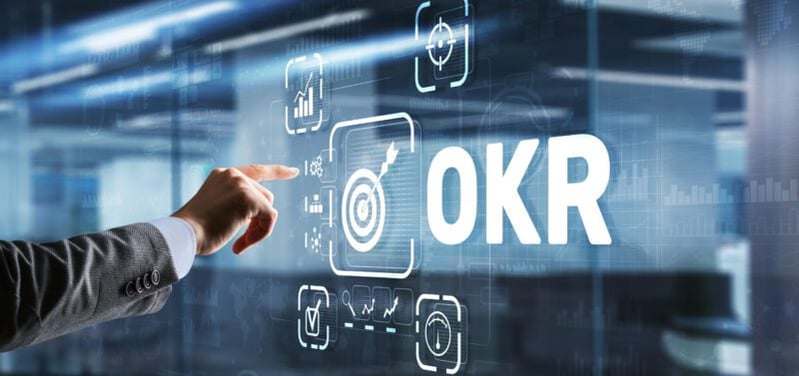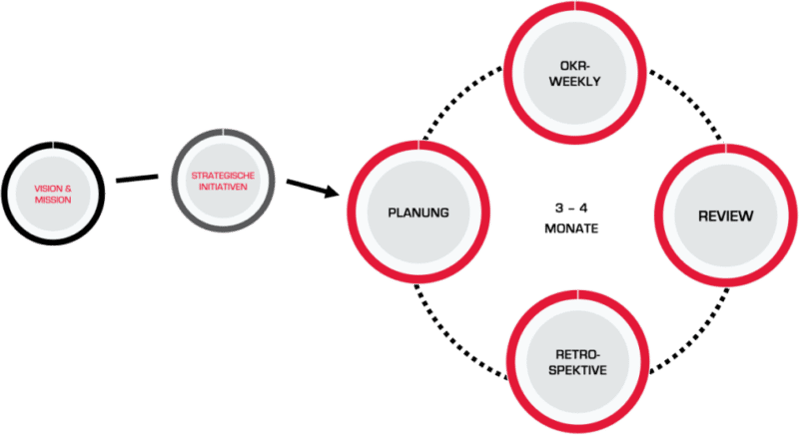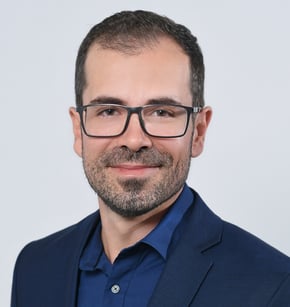Do you know OKR? This abbreviation stands for the management method “Objectives and Key Results” and became known through its use in large US companies. According to its own statements, Google became successful thanks to this method, and LinkedIn and other companies also use OKR. But this type of agile management is not only interesting for big businesses: In our Kitchen Talk #3, we spoke with Ralph Keller, an expert in digital leadership and OKR for IT service providers, about digital leadership in SMEs and also about objectives and key results. As digital work continues to be a relevant topic for many companies, in this blog post we would like to take a closer look at what OKR is and how it can be implemented remotely and in the home office in combination with agile workforce management.

What Is the OKR Method?
As already mentioned, OKR is a management method or leadership tool with the help of which companies jointly develop and focus on goals with the involvement of their employees. The goals of the organization are linked to those of the teams and employees and measurable results (key results) are assigned to each goal (the objective), so that the planning becomes quantifiable and comprehensible.
What is particularly interesting here is that these goals are not only set by management: the majority are developed in the work cycles by the agile teams themselves and subsequently implemented. This leads to more transparency and growing trust within a company. In addition, before OKR is implemented, each employee is clearly communicated what the company’s goal is, which builds a common focus. Agile leaders must have confidence in the work of the teams and not make decisions from the management level, as is often the case in hierarchical organizations.
OKR focuses primarily on clarity, openness and also feedback from within the company. By clearly structuring and dividing goals as well as desired results, necessary learnings and assistance also become clearer, which helps the company and employees enormously.
But even if you formulate objectives precisely, there is always the possibility of unexpected changes. Adaptability to constantly changing conditions is therefore essential for companies, which is why agile models are important and helpful. In agile leadership and working methods, goal orientation is always one of the most important cornerstones, as are the company’s own values and trust in its employees. In such an environment, it is possible to talk openly about problems and offer flexible solutions without losing sight of the big picture and thus the corporate goal. Since the OKR process is not only established by managers, but also includes the goals of team members, it fits perfectly into agile leadership models. Finally, after each cycle, the actual process and its parameters are reviewed, discussed and adjusted via retrospective/review. The process thus continuously improves itself.
OKR Framework And Mode Of Operation
OKR Frameworks for Success
OKRs should be aligned with the organization and have a clear mission. However, before you create them, you should be clear about how many you need and for what periods of time. There are three levels to consider:
1. Normative Level (5+ years):
- The basic vision of the company
- Basis, but not a direct component of the OKR method
2. Strategic Level (1 year):
- Formulate subdivision of the normative level into subgoals
- Medium-term goals
- Formulated by management and executives
- 2-5 OKR are a good cut
3. Operational level (3-4 months):
- Division of strategic goals into operational implementations
- Formulated by the teams
The OKR cycle can be constantly adapted, as it is an agile process and not a rigid system. To start, OKR cycles of 12 months at the strategic level and 3 months at the team level are often appropriate. This also fits in well with the fiscal year, although you shouldn’t just stick to that.

But how do you create these Objectives and Key Results?
1. The vision – the basis for the objective
First, you should be aware of a business goal. To do this, it helps to ask yourself the following questions:
- What is our company all about?
- What do we stand for?
- Who gets value from what we do?
- What is this added value?
- What problems are solved?
- What profit do you achieve with it? (For example, thought of as a team, organization or even larger).
2. The concrete objective (goal)
From the basis, concrete sentences are formulated as objectives. It is important here that ambitious goals are also viewed realistically. Employees and teams therefore develop these themselves. As a rule, only 40% of the objectives should come from the management level and 60% from the teams (the operational level). This way, you keep track of all areas and don’t forget any upcoming goals and options.
3. Key Results
To ensure that the objectives can really be achieved, they must be measurable and traceable. Key results are used to determine such concrete, quantitative metrics. KPIs (Key Performance Indicators) can be used as a guide. Well-known KPIs are, for example, a specific sales target, sales growth, net profit, number of customers acquired, return on investment (ROI), etc.
Agility and transparency
Once the OKRs have been formulated, it is important that all employees of the company have access to the information in order to be able to actually keep the goals in view. It can also happen that certain goals span several teams, and thus cross-departmental collaboration takes place. Managers bear responsibility for transparent communication.
The OKR process is customizable and changeable. At the same time, there is a disciplined focus on those same established goals. After an OKR cycle of 3 months on average, these are evaluated, questioned again and reset.
It is also important to remember that OKRs are neither tasks nor KPIs, but can only target certain KPIs as outcomes. Tasks are derived from the Key Results, which can also be adapted according to the conditions within the OKR cycle.
In agile management, a leader defines the initial framework for tasks and work and regularly monitors the status. This can be an OKR master, for example, which then requests updates in daily or weekly meetings. Agile leadership thus drives transformation and vision. For this to succeed, it is important that all roles and processes are clearly communicated within the company. These are also benefits that are noticeable in the home office, because thanks to agile methods, teams do not necessarily have to sit in the office next door.
Advantages Of OKR And Agile Employee Management
The OKR method fits ideally into agile leadership, as the objectives and key results are jointly designed with the operational teams and communicated transparently. Furthermore, they are constantly adapted to the new or existing circumstances.
This fits perfectly with agility, which means quickly adapting a company, its business model and its work to new requirements. The methods and the mindset of the employees must match. In agile leadership, there are certain hierarchies, but not strict ones in which all tasks are distributed top-down. An agile leader must successfully guide employees and teams and model open communication within the organization. However, the work and goal setting occur across all levels.
This is what an agile leader must achieve
For agile working to function optimally, a culture of trust is needed within the company. Particularly when employees are in a home office, they must be trusted to work independently and with a focus on success. In this way, employees are encouraged to get more involved and to actively find solutions instead of waiting for central guidelines from the management level. Too many rigid, bureaucratic requirements paralyze innovation as well as modern working and are a hindrance, especially in the home office, as accessibility can be limited at times.
Processes can be reviewed and optimized through regular feedback rounds. As an agile leader, you have to introduce these and encourage your employees to find the best solutions themselves, to move forward, and not to lose sight of the big picture and thus the objectives.
Work Agile With OKR
To get started with the OKR methodology, an OKR coach can introduce your company to the topic. Once the basics are clear, it is important to constantly review your agile management and adapt it to the latest circumstances. None of these methods is rigid and unchangeable. Agility suits modern companies: if orders, customers or teams change, the objectives and key results can be adapted to the new circumstances.
Especially in a digital world where more and more people work remotely and in home offices, agile principles based on trust and ownership are very useful. But it is important to convene ongoing check-ins to discuss tasks, strategies and goals, and to make big decisions. In this way, agile management becomes a well-run process in which everyone in the company can develop together and learn from each other.
At Dinotronic, we have been successfully implementing OKR for several years. Are you also curious? For more information on implementing an agile leadership model, please do not hesitate to contact us.

